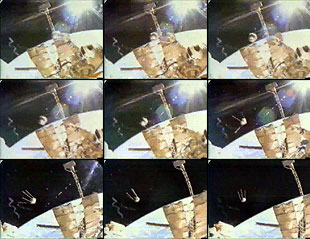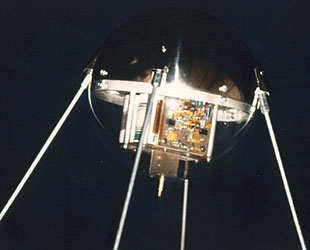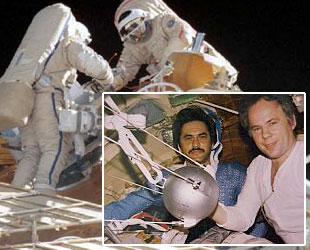October 1, 2007 — One day shy of a month after Sputnik 1 made history as the world's first man-made satellite, the Soviet Union launched Sputnik 2. This time, in addition to radio transmitters like that of its predecessor, the satellite carried the first animal into orbit, a dog named Laika.
This is not the story of Sputnik 2. Rather, the #4 Sputnik on our countdown, the second Sputnik in space, was not launched until 40 years (to the day) after Laika left Earth.
On November 3, 1997, cosmonaut Pavel Vinogradov was on-board the Russian Mir space station. More precisely, he was outside the orbiting platform, performing a space walk with Anatoly Solovyov to remove a solar panel that was to be replaced three days later during another outing.
Before returning inside, Vinogradov took hold of a replica of Sputnik 1 and giving it a good toss, launched the small satellite into orbit.

Still frames from a video showing Pavel Vinogradov (lower right) launching Sputnik 40 into orbit on November 3, 1997. |
Dubbed Sputnik 40 (but also referred to as RS-17a), the 1/3 scale satellite was designed by students in Russia and France to commemorate the 40th anniversary of the launch of the larger, original Sputnik on October 4, 1957. Like its namesake, Sputnik 40 also broadcasted a signal that amateur radio operators could tune in and detect. It actually 'out-beeped' Sputnik 1, as Sputnik 40's batteries allowed its radio to continue functioning for several weeks longer than the original satellite.
Sputnik 40 was launched to the Mir space station on an unmanned Progress supply ship, and it wasn't alone. A duplicate 8-inch, six pound Sputnik (RS-17b) also made it to Mir, but was never tossed overboard. It was still on the station when Mir was de-orbited and destroyed in 2001.

Sputnik 40 with transmitter exposed (AMSAT-France) |
Two more mini-Sputniks were hand launched during the Mir program. Sputnik 41 (RS-18) was deployed by Sergei Avdeyev on November 11, 1998. His partner for the EVA, Gennady Padalka reportedly advised Avdeyev to "toss it gently toward the Moon." The upgraded Sputnik 1 replica broadcast recorded voice messages in addition to beeps.
The fourth and final scale satellite, Sputnik 99 was more notable for the controversy it ignited before leaving Earth than for its flight in orbit. RS-19 was built by the amateur radio operators association of France (AMSAT-France) at the request of the Russian space program, which wanted the small Sputnik to utilize "internet beat time," a method developed by the Swatch Group of Switzerland.
The project, dubbed 'Beatnik', was represented as being non-commercial in nature but Russia then contracted with the watchmaker to allow the broadcast of advertising in the form of voice and text messages. Concerned that the launch would set a precedent for the commercial use of amateur radio waves, operators worldwide filed protest to Beatnik. Bowing to the objections, Swatch withdrew from the project just one day before it was to be thrown off Mir.
Sputnik 99 was still launched on April 16, 1999, but ESA astronaut Jean-Pierre Haigneré was instructed to turn off its transmitter before releasing the miniature Sputnik into orbit.

Pavel Vinogradov and Anatoly Solovyov spacewalk on Mir. Inset: Vinogradov and Solovyov with Sputnik 40 inside Mir. |
Learn more: 
